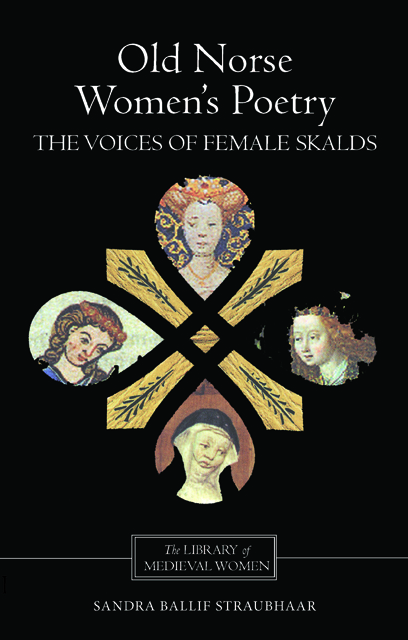Book contents
- Frontmatter
- Contents
- Foreword
- Abbreviations
- Introduction
- I. Real People, Real Poetry
- II. Quasi-Historical People and Poetry
- III. Visionary Women: Women’s Dream-Verse
- IV. Legendary Heroines
- V. Magic-Workers, Prophetesses, and Alien Maidens
- VI. Trollwomen
- Old Norse Literature Time Line
- Glossary of Personal Names
- Bibliography
- Index of Names
- Library of Medieval Women
VI. - Trollwomen
Published online by Cambridge University Press: 14 February 2023
- Frontmatter
- Contents
- Foreword
- Abbreviations
- Introduction
- I. Real People, Real Poetry
- II. Quasi-Historical People and Poetry
- III. Visionary Women: Women’s Dream-Verse
- IV. Legendary Heroines
- V. Magic-Workers, Prophetesses, and Alien Maidens
- VI. Trollwomen
- Old Norse Literature Time Line
- Glossary of Personal Names
- Bibliography
- Index of Names
- Library of Medieval Women
Summary
The trollwomen who haunt a certain subtype of the fornaldarsögur (legendary sagas) are almost always hostile towards the human men they encounter, usually in remote places far away from human settlements. There are often ownership disputes over fishing-grounds, boats and fishermen’s huts. Verbal violence, often in verse, usually escalates into physical violence. Since trolls are often said to live in the north and to have alien facial features, clothing, and manners, it is no great leap to conclude that many troll-encounter stories have had their roots in real-world meetings and misunderstandings between Norse-speakers and Sámi-speakers.
Of course there are exceptions that prove the rule. A few notable warm encounters involving trolls and humans are sprinkled thoughout these legendary sagas as well, such as the kiss exchanged between Hjálmþér and the horse-monster Vargeisa (below); or the romance between Ǫrvar-Oddr and the giant-maiden Hildigunnr, who first keeps the hero in a baby’s cradle, but later bears him a child (also below).
It is worth noting that the taxonomy of non-humans in these legendary sagas is nothing like as exact as we postmodern, post-Linnean readers, perhaps brought up on Dungeons and Dragons manuals in which the carefully delineated varieties and types of trolls are listed in loving detail, might expect. Trolls (troll), giants (jǫtnar) and fabulous monsters (finngálkn) constitute variable categories amongst themselves; and any of them might be human enough to breed with.
Bragi Boddason’s Trollwoman
Setting: Legendary Norway (ostensibly ninth century)
Snorri Sturluson, Edda: Skáldskaparmál, ed. Faulkes, I, 85, stanza 300
FJ IB, 172; Kock I, 92
SPSMA (ed. Edith Marold):
http://skaldic.arts.usyd.edu.au/db.php?table=verses&id=1295
Bragi Boddason ‘the Old’ is the semi-legendary first of all skalds. This stanza follows one of Bragi’s describing what a skald is. Both stanzas are (presumably deliberately) encrusted with obscure and difficult kennings.
Forað
Setting: Legendary Norway
Ketils saga hoengs, ch. 5 (FSNL II)
FJ IIB, 303–5; Kock II, 161–2
SPSMA (ed. Beatrice La Farge):
http://skaldic.arts.usyd.edu.au/db.php?table=verses&id=1295 ff
The Norwegian hero, Ketill hœngr (Ketill Salmon), is taunted by a trollwoman while on a fishing trip
The following are Forað’s stanzas only; Ketill’s part of the conversation in the saga is also in verse.
- Type
- Chapter
- Information
- Old Norse Women's PoetryThe Voices of Female Skalds, pp. 101 - 114Publisher: Boydell & BrewerPrint publication year: 2011



